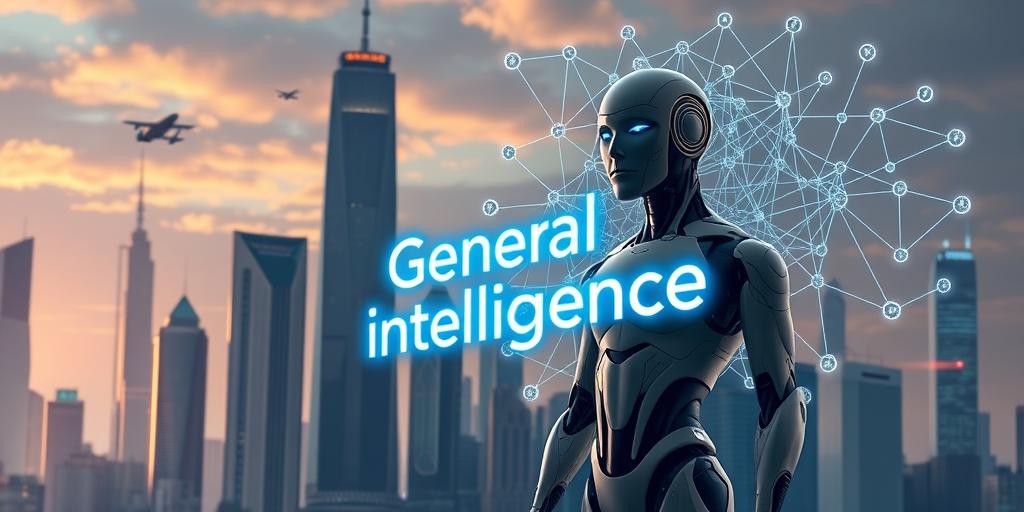The idea of machines that can think and learn like humans has captivated the imaginations of scientists, philosophers, and the general public for centuries. This fascination has fueled the development of AI, a field that seeks to create intelligent machines capable of performing tasks that typically require human intelligence. But how close are we to achieving true AI Intelligence, capable of matching or surpassing human abilities?
The Quest for General Intelligence
The ultimate goal of AI research is to develop Artificial General Intelligence (AGI), systems that possess the ability to understand, learn, and reason like humans. This ambitious goal is often referred to as “human-level AI,” signifying AI systems that can perform any intellectual task that a human can.
Defining Human-Level AI
Defining human-level AI is not straightforward. It involves much more than just replicating specific human cognitive abilities. We need to consider the multifaceted nature of human intelligence, encompassing abilities like:
- Problem-solving: The ability to analyze situations, identify problems, and devise effective solutions.
- Creativity and Innovation: The capacity to generate new ideas, concepts, and solutions.
- Emotional Intelligence: The ability to understand and manage emotions, both in oneself and others.
- Social Interaction: The capacity to communicate, cooperate, and build relationships with others.
The Promise and Peril of AGI
The potential benefits of AGI are immense. Imagine a world where AI systems can solve complex scientific problems, accelerate medical breakthroughs, and address global challenges like climate change. However, the development of AGI also raises significant ethical and societal concerns.
- Job Displacement: The widespread adoption of AGI could lead to significant job losses, requiring a fundamental rethink of the future of work.
- Bias and Fairness: AI systems are trained on data, which can reflect existing biases. This can lead to unfair outcomes, particularly in areas like healthcare and criminal justice.
- Control and Safety: As AI systems become more powerful, ensuring their safety and preventing misuse becomes increasingly crucial.
Current State of AI: Narrow vs. General
While the vision of AGI remains a long-term goal, AI research has made remarkable progress in recent years. However, it’s important to distinguish between the different types of AI currently in development:
Narrow AI: Excelling in Specific Tasks
Narrow AI, also known as “weak AI,” focuses on performing specific tasks. These systems are highly specialized, excelling in areas like:
- Image Recognition: AI systems like Google Photos can identify objects and faces in images with incredible accuracy.
- Language Translation: AI-powered translation services like Google Translate can instantly translate text between multiple languages.
- Recommendation Systems: AI algorithms power personalized recommendations on platforms like Netflix, Amazon, and Spotify.
General AI: The Holy Grail
General AI, on the other hand, aims to create systems that can perform any intellectual task that a human can. It’s still an elusive goal, but researchers are constantly pushing the boundaries of AI capabilities.
Key Challenges on the Path to AGI
Achieving AGI requires overcoming several fundamental challenges:
Embodiment and Interaction
Human intelligence is deeply intertwined with our physical bodies. We interact with the world through our senses, enabling us to learn and adapt. Replicating this embodied intelligence in AI systems is a significant challenge.
Common Sense Reasoning and Understanding
Humans possess a vast amount of common sense knowledge, allowing us to navigate everyday situations with ease. Teaching AI systems this kind of intuitive understanding is a major hurdle.
Learning and Adaptability
Humans are lifelong learners, constantly adapting to new situations and information. Creating AI systems that can learn and adapt at a similar pace and level of complexity is a major ongoing research area.
Promising Research Directions
Despite the challenges, several research directions hold promise for advancing AI towards AGI:
Deep Learning and Neural Networks
Deep learning, a powerful form of machine learning, has revolutionized AI in recent years. Deep neural networks, inspired by the structure of the human brain, are capable of learning complex patterns and making predictions.
Reinforcement Learning and Evolutionary Algorithms
Reinforcement learning allows AI agents to learn through trial and error, receiving rewards for desired actions. This approach has been used to create AI systems that can play games like Go and chess at superhuman levels.
Cognitive Science and Neuroscience
Researchers are increasingly drawing insights from cognitive science and neuroscience to better understand how the human brain works. This knowledge can inform the development of more sophisticated and human-like AI systems.
Ethical Considerations and Societal Impact
The development of AGI presents a multitude of ethical and societal implications that require careful consideration:
Job Displacement and Economic Disruption
The automation of jobs by AI systems could lead to significant economic disruption. It’s essential to develop strategies for managing job transitions and ensuring that everyone benefits from the progress of AI.
Bias and Fairness in AI Systems
AI systems are trained on data, which can reflect existing societal biases. It’s crucial to develop techniques for mitigating bias in AI systems and ensuring that they are fair and equitable.
The Future of Humanity in an AI-Driven World
The emergence of AGI could fundamentally change the nature of human existence. We need to carefully consider the potential impact of AGI on society, ensuring that it serves humanity’s best interests.
A Glimpse into the Future of AI
The road to AGI is long and winding, but the progress made in recent years suggests that it is not an impossible dream. It is essential to proceed with caution and responsibility, ensuring that AI development aligns with ethical principles and societal values. By embracing the potential of AI while addressing its challenges, we can work towards a future where AI enhances human capabilities and helps us address the world’s most pressing challenges.
The development of AGI is a complex and multifaceted endeavor, requiring collaboration between researchers, policymakers, and the public. By fostering open dialogue, promoting ethical AI development, and ensuring that the benefits of AI are shared by all, we can create a future where AI empowers humanity to reach its full potential.




